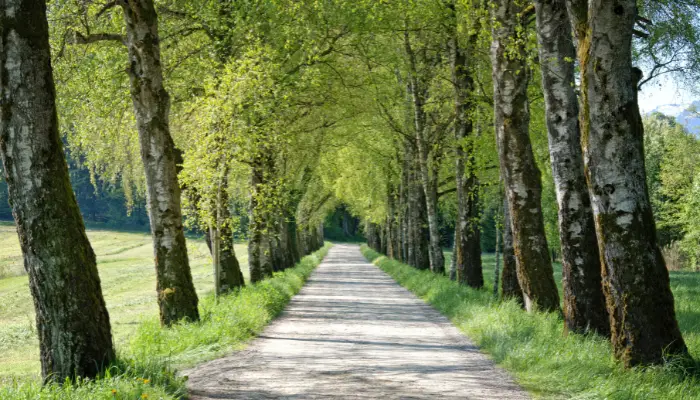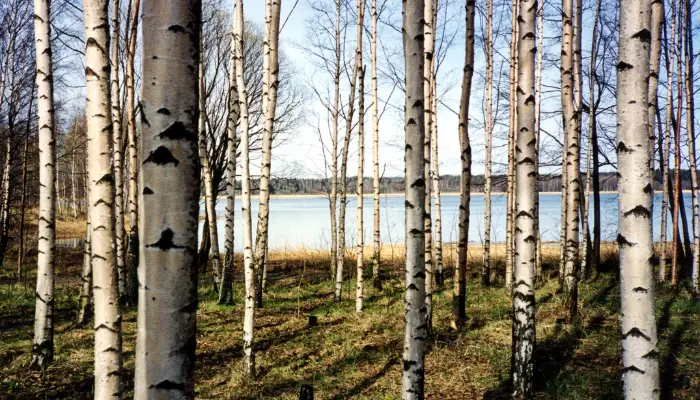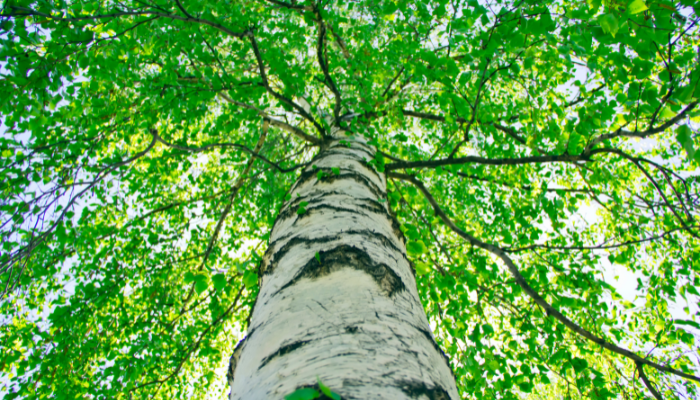River birch trees are beautiful and fast-growing shade trees that thrive in moist and acidic soils. They are native to North America and can tolerate warmer temperatures than other birch species. If you are thinking of adding a river birch tree to your landscape, you might wonder when is the best time to plant it. In this blog post, we will answer this question and provide some tips on how to care for your river birch tree.
The Best Time to Plant a River Birch Tree

The best time to plant a river birch tree is in the spring, from late March to early May, when the soil is moist and the temperatures are cool. This will give the tree enough time to establish its roots before the summer heat and drought stress. Planting in the spring also reduces the risk of frost damage and iron chlorosis, a condition that causes yellowing of the leaves due to iron deficiency in alkaline soils.
If you miss the spring planting window, you can also plant a river birch tree in the fall, from late September to early November, as an alternative. However, you should avoid planting in the summer, when the high temperatures and dry conditions can stress the tree and reduce its survival rate.
How to Plant a River Birch Tree
To plant a river birch tree, you will need a container-grown or balled-and-burlap sapling, a shovel, a tape measure, a wheelbarrow, compost or organic matter, mulch, and water. Here are the steps to follow:
- Choose a location that receives full sun to partial shade and has moist, acidic, and well-drained soil. River birch trees can grow up to 70 feet tall and 60 feet wide, so make sure you have enough space for them. Avoid planting near pavement, buildings, or power lines, as the roots can damage them.
- Dig a hole that is two to three times the width and the same depth as the root ball or container of the sapling. You can use a tape measure to check the dimensions. Loosen the soil at the bottom and sides of the hole with a shovel or a fork.
- Remove the sapling from the container or cut off the burlap and wire around the root ball. Gently loosen the roots and place the sapling in the center of the hole. Make sure the top of the root ball is level with the surrounding soil surface.
- Backfill the hole with a mixture of native soil and compost or organic matter. Tamp down the soil lightly to remove air pockets and water the sapling thoroughly.
- Apply a layer of mulch around the base of the sapling, leaving a few inches of space around the trunk. Mulch will help retain moisture, regulate soil temperature, and prevent weeds. You can use wood chips, pine needles, bark, or leaves as mulch.
- Water the sapling regularly, especially during the first year, to keep the soil moist but not soggy. You can use a drip irrigation system or a soaker hose to provide slow and deep watering. Avoid overhead watering, as it can cause fungal diseases and leaf scorch.
- Fertilize the sapling in the spring with a balanced, slow-release fertilizer, following the label instructions. Do not fertilize in the fall, as it can stimulate new growth that is vulnerable to frost damage.
- Prune the sapling in the winter or early spring, when it is dormant, to remove dead, diseased, or damaged branches. You can also prune to shape the tree or thin out the canopy, but do not remove more than one-third of the branches at a time.
Benefits of Planting a River Birch Tree

Planting a river birch tree can provide many benefits for your landscape and the environment. Here are some of them:
- River birch trees have attractive, peeling bark that reveals a salmon-red inner layer. The bark adds interest and texture to the winter landscape, when the leaves are gone.
- River birch trees have glossy, green leaves that turn yellow in the fall. The leaves provide shade and cooling in the summer and create a colorful display in the autumn.
- River birch trees produce catkins, which are long, slender, and pendulous flowers that appear in the spring. The catkins attract pollinators, such as bees and butterflies, and provide food for birds and small mammals.
- River birch trees have a fast growth rate, reaching maturity in about 20 years. They can also live up to 75 years, depending on the growing conditions and care.
- River birch trees are adaptable and resilient, tolerating a range of soil types, pH levels, and moisture levels. They are also resistant to most pests and diseases, such as birch borer and bronze birch borer.
- River birch trees are excellent for erosion control, as their roots help stabilize the soil and prevent runoff. They are also good for water quality, as they filter pollutants and nutrients from the runoff.
Can You Grow a River Birch Tree From Seed?
Yes, you can grow a river birch tree from seed, but it requires some patience and care. Here are the basic steps to propagate a river birch tree from seed:
- Collect the seeds from the catkins (the long, slender flowers) of a mature river birch tree in late spring or early summer, when they turn brown and dry. You can shake the branches gently to dislodge the seeds, or cut off the catkins and place them in a paper bag.
- Store the seeds in a cool, dry place until late fall or winter, when you are ready to sow them. You can also stratify the seeds in the refrigerator for two to three months to improve their germination rate. To do this, mix the seeds with some moist peat moss or sand in a plastic bag and seal it. Check the bag periodically and keep the medium slightly damp.
- Sow the seeds in a tray or pot filled with a well-drained, acidic potting mix. Scatter the seeds thinly over the surface and cover them lightly with a thin layer of soil. Mist the soil with water and press it gently to increase contact with the seeds.
- Place the tray or pot in a cold frame or a sheltered area with indirect sunlight. Keep the soil moist but not soggy, and protect the seeds from frost, rodents, and birds. You can also use a heating mat to warm the soil to 85 F during the day and 70 F at night, which may speed up the germination process.
- Wait for the seeds to germinate and sprout, which may take four to six weeks or longer, depending on the temperature and moisture conditions. Thin out the seedlings to avoid overcrowding and transplant them to individual pots when they have two or three true leaves.
- Grow the seedlings in a sunny, sheltered spot until they are ready to be planted in the ground. This may take one or two years, depending on the growth rate and size of the seedlings. Choose a location that has moist, acidic, and well-drained soil, and enough space for the tree to mature. Plant the seedlings in the spring or fall, when the soil is moist and the temperatures are cool. Water them regularly and mulch them to conserve moisture and prevent weeds.
How long Does it Take For a Fiver Birch Tree to Grow?
According to some sources, river birch trees can grow anywhere from 1 to 2 feet per year, depending on their growing conditions and age. They can reach 30 to 40 feet in 20 years, or 10 feet in 10 years for dwarf cultivars.
What Are Some Common Problems With river Birch Trees?
Some common problems with river birch trees are:

- Root rot, which is caused by overwatering or poor drainage. The roots become soft and blackened, and the tree may wilt or die. To prevent this, plant the tree in well-drained, acidic soil and water only when the soil is dry.
- Gray mold spots, which are caused by a fungus that infects the flowers and leaves. The affected parts develop brown or gray spots and may fall off. To prevent this, avoid overhead watering and prune off any infected branches.
- Leaf spots, which are caused by various fungi and bacteria that create discolored patches on the leaves. The spots may be circular, angular, or irregular, and may have different colors depending on the pathogen. To prevent this, keep the tree healthy and avoid wounding the bark.
- Aphids, which are small insects that suck the sap from the leaves and stems. They can cause the leaves to curl, distort, or yellow, and may also secrete a sticky substance called honeydew that attracts other pests and diseases. To prevent this, spray the tree with a strong jet of water or use insecticidal soap or oil.
- Sawfly larvae, which are caterpillar-like insects that feed on the leaves and skeletonize them,. They can defoliate the tree if left unchecked. To prevent this, handpick the larvae or use an insecticide that is labeled for sawflies.
What Are Some Benefits of Planting a River Birch Tree?
Some benefits of planting a river birch tree are:
- It has attractive, peeling bark that adds interest and texture to the landscape.
- It provides shade and cooling in the summer and colorful foliage in the fall.
- It attracts pollinators, birds, and small mammals with its flowers and seeds.
- It grows fast and adapts to a range of soil and moisture conditions.
- It helps prevent erosion, filter runoff, and improve water quality.
Conclusion
River birch trees are wonderful additions to any landscape, especially if you have a wet or boggy area. They are easy to grow and care for, as long as you plant them at the right time and provide them with enough water and fertilizer. They will reward you with their beauty, shade, and wildlife value for many years to come.
I hope this blog post has helped you learn more about when to plant a river birch tree and how to do it properly. If you have any questions or comments, please feel free to leave them below. Thank you for reading and happy gardening!
Frequently Asked Questions about Planting River Birch Trees
Q: Can I plant a river birch tree at any time of the year?
A: While it’s possible to plant river birch trees at various times, the ideal periods are late fall or early spring during dormancy. Planting during these times minimizes stress on the tree and promotes successful establishment.
Q: How do I choose the right location for planting a river birch tree?
A: Select a site with well-drained soil and partial to full sunlight. River birch trees are adaptable to different soil types but thrive in slightly acidic to neutral soils.
Q: Should I amend the soil when planting a river birch?
A: It’s generally not necessary to amend the soil unless it is extremely compacted or poor in quality. River birches can adapt to a variety of soil conditions, and adding organic matter during planting can help improve drainage.
Q: How often should I water my newly planted river birch tree?
A: Watering frequency depends on factors such as weather and soil moisture. In general, water the tree deeply immediately after planting and then regularly for the first few months. Once established, river birch trees are relatively drought-tolerant.
Q: When can I expect my river birch tree to start showing new growth after planting?
A: River birch trees typically exhibit new growth in the spring, shortly after the dormant season. However, individual growth rates may vary based on environmental conditions and the tree’s overall health.
Q: Is pruning necessary after planting a river birch tree?
A: While minimal pruning may be required to remove dead or damaged branches, extensive pruning immediately after planting is not recommended. Allow the tree to establish itself first before shaping or pruning for desired form.
Q: Can I transplant a mature river birch tree, and if so, when is the best time to do so?
A: Transplanting mature river birch trees is challenging and should be approached with caution. If necessary, late fall during dormancy is the most suitable time. However, it’s advisable to consult with a professional arborist for guidance on transplanting established trees.
Q: Are river birch trees susceptible to pests and diseases?
A: River birches are generally hardy, but like any tree, they can be susceptible to certain pests and diseases. Regular inspections, proper care, and prompt treatment if issues arise can help maintain the tree’s health.
Q: How fast does a river birch tree grow?
A: River birch trees are known for their moderate to fast growth rate, typically averaging around 1 to 2 feet per year under optimal conditions. Growth rates may vary based on factors such as soil quality, sunlight, and water availability.
Q: Can river birch trees be planted in containers?
A: While river birches are generally not well-suited for long-term container planting due to their size and extensive root system, young trees can be temporarily container-grown before transplanting them into the ground. Ensure proper drainage and use a suitable container size for temporary containment.




